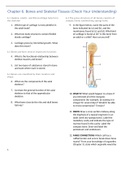Summary
Summary Chapter 6. Bones and Skeletal Tissues (Check Your Understanding Questions)
- Course
- Institution
- Book
Human Anatomy and Physiology (Marieb) - Chapter 6. Bones and Skeletal Tissues Compilation of in-chapter Check Your Understanding questions including answers from Appendix
[Show more]




